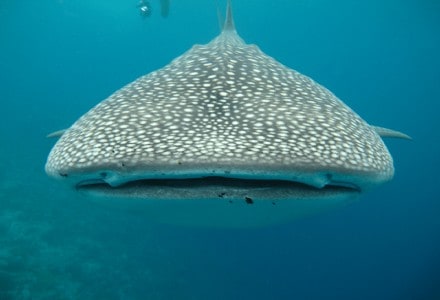
Whale Shark Facts
- Although its bears the scientific name of Rhincodon typus, we know this magnificent animal as The Whale Shark. That common name fits the incredible species perfectly, since it represents the largest known variety of fish in the world. Therefore, the common name refers partly to its great size, since the creature bears no physical relationship to whales.
- Additionally, a military doctor named Andrew Smith became the first known individual to identify the truly massive animal. This identification occurred subsequent to its harpooning, in 1828. However, the actual identification of it as a newfound species did not occur until the following year. The name refers to both its size and method of feeding.
- Presently, no accurate data about the population of Whale Shark throughout its range exists. Nevertheless, the IUCN currently lists the awesome fish as Endangered on its Red List. The international organization assigns this status due to a combination of factors. These include such things as losses to bycatch in commercial fishing and encounters with boats.
Related Articles
Whale Shark Physical Description
Most notably, adult specimens of the Whale Shark attain a truly massive size for a fish. Furthermore, the amazing creature also displays the trait of sexual dimorphism. In its case, this manifests in the tendency of females to attain a larger size than males. Yet, the difference in size remains small.
Overall, mature individuals of the species average roughly 31.8 ft (9.7 m) in length. In addition, these also average about 20,000 lbs (9,072 kg) in weight. However, exceptional individuals have been spotted. These specimens can grow to as large a size as 41.5 ft (12.65 m) long and 47,000 lbs (21,319 kg).
Also, the head develops rather flattened in shape and with a blunt snout. The mouth grows extremely wide, and two short barbels also protrude from its nostrils. It also contains hundreds of rows of tiny teeth. The remarkable Whale Shark also possesses a total of five pairs of relatively large gills.
In terms of appearance, both genders remain visually indistinguishable. The sides and back generally display shades of gray to brown. Meanwhile, the underside typically presents an off-white color. Further, white spots appear among vertical and horizontal stripes. These remain unique to each individual.
- Kingdom: Animalia
- Phylum: Chordata
- Class: Chondrichthyes
- Order: Orectolobiformes
- Family: Rhincodontidae
- Genus: Rhincodon
- Species: R. typus
Photographer: Zac Wolf
CC License: https://bit.ly/24dGLTK
Whale Shark Distribution, Habitat, and Ecology
First of all, the magnificent Whale Shark possesses a nearly global habitat range. Secondly, this holds true due to the fact that it appears in all temperate and tropical waters. But, the greatest known concentrations of this fascinating fish occur off the coasts of the continents of Australia, Africa, and Asia.
Although its does inhabit the open sea, the giant fish rarely ventures into truly deep areas. Secondly, it will also, in fact, occasionally enter bays and lagoons. However, the species typically prefers mid-range depths in the open water. Nonetheless, the species can dive to depths of as much as 4,200 ft (1,280 m).
As filter-feeders, it feeds primarily on plankton, krill, certain types of algae, and small squid and invertebrates. Its many rows of numerous teeth also give it a frightening image. But these play no role in its feeding processes. Aside from the fact that it evolved as ovoviviparous, nothing is known of its reproductive practices.
Yet another area lacking complete reliable data is its lifespan. Although the Whale Shark appears to have an average lifespan of about 70 years, its maximum lifespan remains undetermined. However, some researchers estimate that the creature has a natural potential lifespan of about 130 years.
Finally, the truly incredible fish also typically has an extremely calm temperament. In fact, it often allows divers to ride along on it. But researchers and conservationists discourage this practice. That’s because the activity disturbs its natural patterns. In general, though, it poses no direct threat to humans.
Species Sharing Its Range
Maui Dolphin Mimic Octopus Blue Shark
Check out our other articles on 5 Amazing Galapagos Islands Species, Black Rain Frog, Salar de Uyuni, Bomarea, Pinta Island Tortoise, Jewel Wasp, Inaccessible Island Rail

